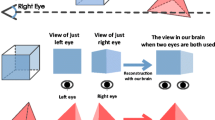Abstract
This paper discusses the exploratory application of holography to photoelasticity. It is shown that the two-beam holographic method may be used to record the birefringent pattern of a standard two-dimensional photoelastic specimen. A special type of polariscope is required. A discussion is presented of the various arrangements required to produce isochromatic, isoclinic, isopachic and combined isopachic and isochromatic fringe patterns. The three-dimensional nature of the holograph is utilized to separate the principal stresses by means of oblique incidence. Both normal- and oblique-incidence fringe patterns are recorded on a single hologram. A brief discussion of the extension to the dynamic case is presented.
Similar content being viewed by others
References
Gabor, D., “A New Microscopic Principle,”Nature,161,777 (1948).
Leith, E. andUpatnieks, J., Jnl. Opt. Soc. Am.,52,1123 (1963).
Stroke, W., An Introduction to Coherent Optics and Holography, Academic Press, New York (1966).
Leith, N., Upatniels, J., andHaines, A., “Microscopy by Wavefront Reconstruction,”Jnl. Opt. Soc. Am.,55,8 (August1965).
Favre, H., “Sur une nouvelle methode optique de determination des tensions interieures,”Rev. Optique,8,193–213,241–261, 289–307 (1929).
Frocht, M. M., “Isopachic Stress Patterns,”Jnl. Appl. Phys.,10,248–257 (1939).
Sinclair, D., “Interferometer Methods of Plane Stress Analysis,”Jnl. Opt. Soc. Am.,30,511–543 (1940).
Post, D., “A New Photoelastic Interferometer Suitable for Static and Dynamic Measurements,”Proc. SESA,12,1,191–212 (1954).
Nisida, M., andSaito, H., “A New Interferometric Method of Twodimensional Stress Analysis,”Proc. SESA,21,2,366–376 (1964).
Brooks, R. E., etal., “Holographic Photography of High-Speed Phenomena with Conventional and Q-Switched Ruby Laser,”Appl. Phys. Letters,7,92–94 (1965).
Timoshenko, S., Phil. Mag.,44,1014 (1922).
Frocht, M. M., Photoelasticity, Vol. II, John Wiley & Sons, Inc., New York (1948).
Drucker, D. C., “Photoelastic Separation of Principal Stresses by Oblique Incidence,”Trans. ASME,65,A-156 (1943).
Author information
Authors and Affiliations
Rights and permissions
About this article
Cite this article
Fourney, M.E. Application of holography to photoelasticity. Experimental Mechanics 8, 33–38 (1968). https://doi.org/10.1007/BF02326248
Issue Date:
DOI: https://doi.org/10.1007/BF02326248




